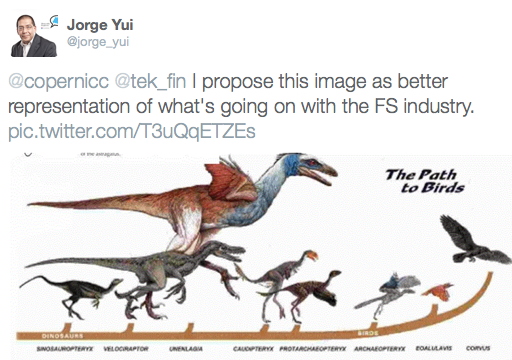I’m lucky to have a job where I have the opportunity to meet a lot of innovators in financial services and fin-tech. As a consequence I build up a sense of the state of the industry and the key trends ahead, and I love to share these insights on this blog.
Of course, I had the finger on the pulse of the fin-tech startup community in my Innotribe job in the last 4 years. Now, working for the Bill & Melinda Gates Foundation, I focus on building financial payment platforms for the poor people and thus meet a wide range of stakeholders – governments, banks and central banks, telcos, mobile money operators, technology giants and startups. I can tell it makes for a very wide perspective and I do spend considerable time thinking and integrating this rich input.
I love doodling as well, so when inspiration comes I take my iPad and my faithful Jot pen and I try to capture this in a drawing. Here’s the latest one – a cartoon depicting in a funny way what I think is the state of the consumer financial services industry.
I’ve posted it on Twitter and it generated an incredible amount of interest, so I thought I’d share some more about the underlying thinking, and also some additional insights coming from the numerous comments on Twitter.
 Well, optimist that I am, I really thought of my drawing as a cartoon, exaggerating a situation to make a point. Philip rightly points out that sometimes real life is itself an exaggeration!
Well, optimist that I am, I really thought of my drawing as a cartoon, exaggerating a situation to make a point. Philip rightly points out that sometimes real life is itself an exaggeration!
Indeed, I don’t think someone will acquire a global bank with 2 trillion US dollars in its balance sheet. But the point is not about acquisition, it is about who will eat these bank’s lunch if they don’t pay attention. Telcos are tempted to provide financial accounts, even though it makes them getting into the murky (for them) waters of financial regulation. In fact, in my focus countries (Nigeria, Indonesia, India, Pakistan and Bangladesh), telcos are probably best placed to reach out to poor people in remote, rural areas.
By delivering financial accounts and person-to-person payments, telcos and other mobile money operators are developing the next generation of low cost payments platforms. My belief is that these new platform will simply prevail in the traditional financial system (often referred to as “the rails”) – why in the world would we continue to use more complex and costly variants? In other words, if banks don’t embrace these new recipes for lower cost rails, they will be in dire straits. The readers of my book (“The Castle And The Sandbox”) will recognise this argument – banks will need to step out of their established “castles” and innovate and experiment in “sandboxes” to understand and adopt these new platforms.
The bounty, the vision, is the volume that will be brought in the system by the 2,5 Billion people who are currently out of any financial system.
Agreed, the predators are everywhere. Just to prove the point that banks can indeed step out of the castle, Simple was recently acquired by BBVA. I knew this when I drew the cartoon, and voluntarily included Simple in the “startups” cloud, just to show that nothing is really simple in the fin-tech eco-system 🙂
There is a show on French TV (“On n’est pas couché”) that used to start by introducing who is NOT invited to the show. Similarly, I’ve had a number of comments about who is not shown in the cartoon, and notably Paypal, Visa and MasterCard.
For me, the core business of these companies is really part of the current “rails”, so in my mind they are included in the “banks” cake in the cartoon. I know this is a big shortcut, and I can hear all the objections coming. But hey, as the author of the cartoon, I can choose who to invite in, right? 😉
More seriously, I do think Paypal, the card companies, and indeed many banks do have innovative products and services “on the rails”. If you are following my blog you know that I’m a big fan of Paypal for international payments.
Now, on to the “hot” topic!
I hope Philippe will comment on this post and explain more. I love the way Tomasz has captured my meaning – “Bitcoin slowly but surely heats up the pan”. I’ve written here why I think Bitcoin is important for the fin-tech industry – in a nutshell it’s not about the Bitcoin currency (which may or may not become one of the trading currencies on par with the RMB or the USD) but about the bitcoin (lowercase) inspired technology: the bitcoin blockchain and its massively distributed architecture. I believe this architecture will influence how the financial transactions are performed in the future. I used the opportunity of this post to add Ripple to the cartoon – I’ve also written about how this company uses the bitcoin blockchain architecture to perform very low cost international money transfers.
Gigi has the last word on bitcoin – financial technology, all electrons that it is, needs to contribute, as all other industries, to the massive ecological problem we are facing as a civilisation.
Danièle, Sam, and all the numerous others who have retweeted and favorited my tweets – many thanks for your kind words!
And I give the final word – pardon, picture – to Jorge. And Jorge please comment below and tell us more on your thinking!












